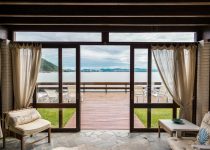How to Install Outdoor Wall Lighting
To install outdoor wall lighting, start by turning off the power at the circuit breaker. Use a voltage tester to confirm that there's no electricity. Remove any existing fixture and attach a new mounting bracket to the junction box, ensuring it's level. Connect the wires: black to black, white to white, and green/bare to ground using wire nuts. Follow the manufacturer's instructions to secure the fixture and seal gaps with silicone caulking. Regular maintenance, like cleaning and inspecting for wear, will keep your lights shining bright. If you want to explore more tips and options, just keep going!
Table of Contents
Key Takeaways
- Turn off power at the circuit breaker and confirm with a voltage tester to ensure safety during installation.
- Remove the existing fixture by unscrewing screws and disconnecting the wiring carefully.
- Attach a new mounting bracket to the junction box securely, ensuring it is level and tight.
- Connect the new fixture's wires: match black to hot, white to neutral, and green/bare to ground.
- Install the fixture according to the manufacturer's instructions and seal any gaps with silicone caulking.
Benefits of Outdoor Lighting
Outdoor wall lighting offers several key benefits that can transform your property's exterior. First and foremost, it enhances security by illuminating dark areas around your home, deterring potential intruders and ensuring the safety of you and your family.
With well-placed outdoor lighting, you can navigate your property with ease during nighttime, reducing the risk of falls or accidents in poorly lit spaces.
Additionally, outdoor lighting significantly boosts curb appeal, creating a welcoming atmosphere that enhances your home's aesthetic value. When you highlight architectural features and landscaping with strategically positioned lights, your property gains depth and visual interest, making it more attractive when the sun goes down.
Moreover, many outdoor lighting options are now energy-efficient, utilizing LED bulbs and motion sensors. These technologies not only lower your electricity costs over time but also contribute to a more sustainable environment.
Types of Wall Lights
When it comes to choosing wall lights for your exterior, you'll find a variety of options that cater to different needs and styles. Here are some common types you'll want to consider:
| Type | Features | Ideal Use |
|---|---|---|
| Sconces | Wall-mounted, ambient lighting, various designs | Enhance architectural style |
| Floodlights | Powerful illumination, motion sensors available | Security and outdoor activities |
| Lanterns | Decorative, charming design | Welcoming atmosphere on porches |
| Spotlights | Focused beams, highlights specific areas | Landscaping and architectural details |
| Smart Lights | Integrates with home automation | Remote control and programmable settings |
Each type serves a unique purpose—sconces can enhance your home's aesthetic, while floodlights provide safety and visibility. Lanterns add charm, and spotlights help showcase your landscaping features. If you're looking for modern convenience, smart lights offer customizable settings that can adapt to your lifestyle. By understanding these different options, you can select the right exterior light to illuminate your space effectively and stylishly.
Installation Process
Choosing the right wall light is just the beginning; the installation process is key to ensuring your new fixture works safely and effectively.
Start by turning off the power at the circuit breaker. Use a voltage tester to confirm that no electricity is present before proceeding.
Next, remove the existing light fixture by unscrewing the mounting screws and disconnecting the electrical wiring, making sure to document how the wires are connected for reference.
Once that's done, secure the new mounting bracket to the junction box, ensuring it's level and tightly attached to support your new outdoor light fixture.
Now, it's time to connect the wires. Match the black (hot), white (neutral), and green/bare (ground) wires using wire nuts to create a secure and safe connection.
After you've connected the wires, install the light fixture according to the manufacturer's instructions.
Once everything is in place, install the appropriate bulb, restore power, and test for functionality.
Finally, seal any gaps with silicone caulking to prevent moisture intrusion, ensuring your outdoor lighting is ready for use.
Maintenance Tips
To keep your outdoor wall lighting in top shape, regular maintenance is essential. By following these simple tips, you can ensure optimal performance and longevity for your fixtures.
- Clean the Fixtures: Use a soft cloth and a mild soap solution to regularly clean your outdoor wall fixtures. This removes dirt and debris, maintaining brightness and appearance.
- Inspect Wiring and Connections: At least twice a year, inspect wiring and connections for signs of wear or damage. If you notice any issues, consider hiring a professional electrician to address them.
- Check for Rust or Corrosion: Particularly in coastal areas, inspect your fixtures for rust or corrosion. Applying a protective coating can enhance their longevity and safeguard them for outdoor use.
- Schedule Maintenance Checks: Ideally, set up annual maintenance checks. This allows you to assess the condition of your fixtures and ensure they operate safely and efficiently.
Cost Considerations
Installing outdoor wall lighting can be a significant investment, and understanding the associated costs is key to making an informed decision. The average installation cost for outdoor wall lights ranges from $100 to $300 per fixture. This can vary based on the complexity of the project and local labor rates.
If your project needs electrical work beyond just installation, be prepared for additional charges, especially if you hire a licensed electrician.
You might also want to consider energy-efficient LED options. While they often have a higher upfront cost, they can lead to long-term savings on your electricity bills due to their lower energy consumption.
If you're looking to save, you could handle the installation yourself, which typically costs around $50 for materials, excluding any necessary tools.
To gain a clearer picture of your total costs, take advantage of free consultations from lighting professionals. They can assess your project needs and provide estimates tailored to your situation.
Frequently Asked Questions
How to Install a New Outdoor Wall Light?
To install a new outdoor wall light, start by turning off the power. Remove the old fixture, secure the new bracket, connect the wiring, attach the light, and seal it to prevent moisture.
How Do You Hang Outdoor Lights on a Wall?
To hang outdoor lights on a wall, secure the mounting plate, connect the wiring, position the fixture, and fasten it with screws. Don't forget to seal gaps with silicone to prevent moisture intrusion.
Do I Need an Electrician to Install Outdoor Lights?
You might need an electrician to install outdoor lights, especially if you're unfamiliar with electrical work. Hiring a professional ensures compliance with safety codes and provides valuable guidance on fixture placement and energy-efficient options.
Can I Install Outside Lights Myself?
Yes, you can install outside lights yourself if you have basic wiring knowledge and feel comfortable with electricity. Just ensure you turn off the power, follow instructions, and comply with local electrical codes for safety.



